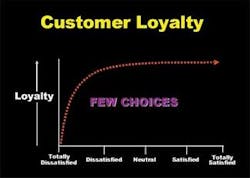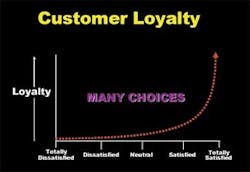Playing favorites
Targeting the right patients can help you build a dream practice.
For more on this topic, go to www.dentaleconomics.com and search using the following key words: relationship–based target marketing, customer satisfaction, feedback.
The word marketing may have lost the unsavory connotation dentists assigned it in the '70s and '80s, but for many it still carries an undertone of mystery. Most dentists use the word “marketing” synonymously with advertising. But given the ever–expanding mesh of media choices available, we're perplexed and frustrated when we need to decide which to use for our practices. We just want the biggest bang for the smallest buck.
Equating marketing with advertising is our first critical error. A magazine ad or radio spot can be a useful tactic, but it's not a strategy. While we're busy scheming to bring new patients in the door, we tend to be less concerned about keeping the patients we already have! Consumer research affirms that it costs us four or five times more to acquire a new customer than to keep an existing one. Still, we can't help wanting to attract more and “better” patients for our practices. So let's create a strategy that accomplishes both — one that boosts loyalty among current patients and attracts ideal new patients.
Welcome to relationship–based target marketing
For many, the only kind of internal marketing we do is asking patients to refer others. But isn't this a bit presumptuous? We assume they are pleased enough with their experience to rave about it to family and friends. Often this is not the case.
Instead of internal marketing that focuses on all patients, relationship–based target marketing (RBTM) focuses on your favorite ones. RBTM can lead you to attract and retain the right patients for your practice. These are the ones you can serve enjoyably, predictably, and profitably.
This article will introduce the study of customer satisfaction and feedback loops. By the time you finish, you may choose to make totally satisfying target patients a cultural imperative for your practice. If you do, you will find the payoff gets deeper and richer every year — for the rest of your practice life. Let's see how it works.
How can you identify the right patients?
You and your team probably have no trouble recognizing the wrong patients for your practice. They are the ones who use an inordinate amount of resources but end up unhappy in the process. These patients deplete a team's energy and often spread disparaging words in the community.
But can you also recognize the right patients for the practice? These patients energize your team because you can serve them enjoyably, predictably, and profitably. Plus they tell others how extremely satisfied they are with their respective experience. Once identified, these patients will be your target market.
Every person on your team must be able to spot these patients immediately, as soon as they call or walk through the door. These patients will partner with you in shaping a practice that attracts others just like them. You will look for opportunities to solicit their feedback, both positive and negative, and revamp “everything.” You will do this one idea at a time. Ultimately, you will build a practice that is a magnet for this target market.
Why build a practice for the few?
Customer loyalty (the intent to repurchase and, in turn, to recommend the practice to others) is not directly related to customer satisfaction. It's true that in noncompetitive markets (such as household utilities) customers are willing to repurchase a service that somewhat dissatisfies them (Fig. 1). After all, what choice do they have?
But in a competitive market like dentistry (Fig. 2), even the satisfied customers (4 on a 1–to–5 satisfaction scale) may not be loyal to you. Patients can seem fairly content, but may be lured away by a lower price, a more convenient location, or a different insurance arrangement. With a phone call, they are gone and you are left hurt and wondering why they left. Here's the truth: In a competitive market, only the totally satisfied patients (5 on the satisfaction scale) will be immune to the attractions of other practices and emerge as true advocates of your practice.
Because you can't wow everyone, you need to focus on creating total satisfaction for the people you most want to serve.
Who should you wow?
To choose a target market, you first need to know your practice, your team, and yourself. With your team, discuss your ideal “service mix” — the procedures you do most predictably, profitably, and enjoyably. Everything rests on this.
Next, work with your team to identify the patients you have served during the past two years who stand out positively. These individuals benefit from your best service mix, are easy to work with, show up for appointments on time, pay bills promptly, are totally satisfied with the outcome, and remain respectful to your team throughout the process. Write down the names of five to 10 individuals who fit this description.
Finally, look for demographic similarities among the patients on your list. Notice trends or commonalities among the group in terms of age, gender, level of health, level of education, type of employment, area of residence, ethnicity, religion, or any other group identification. Once you have this perspective, it should be easy for you to define your target market.
How do you learn what wows them?
Now start asking for their feedback. Many dental teams customarily ask, “How did everything go for you today?” This question usually garners a polite response; however, it is not specific to your target market, nor is it an effective way to glean the information you need to improve patients' experiences.
Be willing to dig deeper with your target patients. Ask them questions that create opportunities for collaboration. For example, “What haven't we thought of that could make a positive difference and show we care for our patients?”
While the answers to such questions might challenge current operating systems, we have everything to gain from them. To the extent that we grow toward our best patients' ideas, this is the extent to which we will attract and retain more target patients.
Making it easier to collaborate with patients
Here are some strategic activities that will provide some structure for your inquiries:
1) Let them in on your secret. When you meet a target market patient initially, let this person know that he or she is among your favorite patients. Also, tell the person you are committed to continual improvement, so you would appreciate feedback about what could be done better.
2) Send them a welcome note. Send each new target patient a handwritten card: “Dear Sally: Welcome! It was so nice to meet you today. We are delighted to have you with us. I hope your first experience here was a positive one. If you find any way that we can do better, either in our care for you or our customer service, please let us know. Your feedback is important for our dedication to continual improvement. Yours sincerely, Susan.”
3) Conduct a target market focus group. Perhaps the most effective activity is to gather a small group of your target patients, with an equal number of team members, to dialogue with you at a meal. During the meal, ask five or six questions and watch them go to work for you.Your questions might be about the new–patient experience, first visit, office environment (such as music choices, odors, and office decor), and administrative ease (such as scheduling, financial arrangements, and billing issues). Ask at least one question about marketing preferences. “If we were to design a print advertisement, hoping to attract a patient just like you, what publication(s) would you suggest we use?” Deeper yet, if your guest suggests a newspaper, ask which section and which day. If it is radio, ask which station and what time of day.
4) Conduct exit interviews. When a target patient leaves, for any reason, ask permission to engage him or her in a dialogue. Let the person know that he or she is among your favorite patients and you would be grateful for help in discovering how you might have improved this person's experience. “Ron, I wonder if you can think of one thing we might do a little better in the way we care for our patients?”
Again, thank the person for the honest feedback and avoid a defensive posture. Remind your exiting target patients that their feedback is crucial to your efforts to build a practice that's more attractive to patients just like them. If you uncover a blunder in your care or service, move to recovery (see No. 5 below). Always end with a warm invitation to return to your practice any time.
5) Employ recovery steps. Your response to the mistakes you make will either raise a patient's image of the practice indelibly, or permanently contaminate it. Whenever you make a mistake in serving a target patient (or any patient for that matter), you need to recover gracefully. Every team member must become adept at recovery.
First, own the problem and apologize. Do not argue or become defensive. Apologize for your blunder and thank the patient for bringing the problem to your attention.
Second, make it right. Grow in your flexibility and creativity to solve problems as best you can, so the patient feels good about the solution you reach.
Third, do something extra. A gift, material or otherwise, is in order for two reasons. First, to say thank you. It tells your target patient how much you appreciate his or her feedback to support your efforts in continual improvement. Second, it communicates to your patient how infrequently you make such mistakes. If you made them every day, you would certainly not be giving away gifts.
For each team member to act autonomously in recovery, it will be important to establish parameters (of time and money) that they are permitted to spend.
6) Engage in other strategic activities. As you develop a healthy skepticism about how patients perceive your care, you will gain new ideas about how to collaborate with patients. Get creative with your team about how to uncover things that have gone wrong and how best to champion your patients for their insights. You may decide to establish a target–patient Board of Directors, hold a target–patient “walk through” to help you see your surroundings with a more critical eye, design a face–to–face chairside survey, or conduct a team brainstorming session during which each team member offers one anonymous (but real) patient complaint or blunder.
The ‘complaint department' is open
Beware! When you ask for feedback, you open yourself up to complaints. Sometimes patients will delve into the nitty–gritty details of a problem they may have encountered. Let them represent the countless patients who have had a negative experience in your office and have not spoken about it — at least to you. After the patient has had his or her say, move from “What happened?” and “Who's responsible?” to “What's possible?” and “How could we do it differently?”
Respond to feedback
It is not enough to thank your patients for their feedback. They often feel uncomfortable, as if they have stuck their neck out too far. Reassure them that you will use this information to improve your care — and now you must do this. Transform your team meeting time to breakthrough thinking that centers on your patients' ideas. Don't be afraid to invest in change. Think toward innovative solutions and resist the urge to review the current protocol. Remember that a paradigm shift occurs when a question is asked inside the current paradigm that can only be answered from outside it.
Create apostles to your practice
Get ready for the payoff. When your favorite patients know who they are, they begin to partner with you in developing a dream practice. They'll tell everyone! They will talk with a sense of pride and belonging to their friends — a much stronger invitation to your practice than just a positive opinion. Before long, your practice will be filled with more and more target patients — friends and family members of your favorite patients. This should ensure a thriving future for you, even in tough economic times.
Dr. Susan Maples has a private practice in Holt, Mich. She graduated in 1985 with a DDS from the University of Michigan, and in 1994 with an MBA from Madonna University. Her mission is to help other business owners enjoy their professional lives more fully. She enjoys speaking and consulting in leadership, team building, marketing, and communication. Reach her via e–mail at [email protected].



